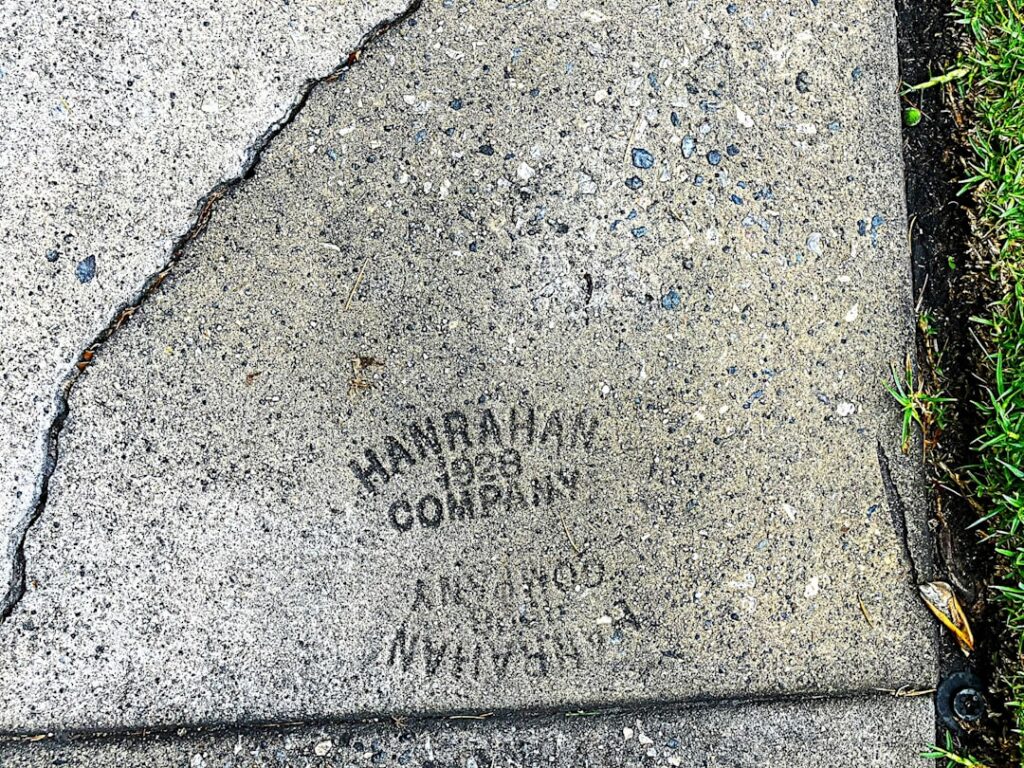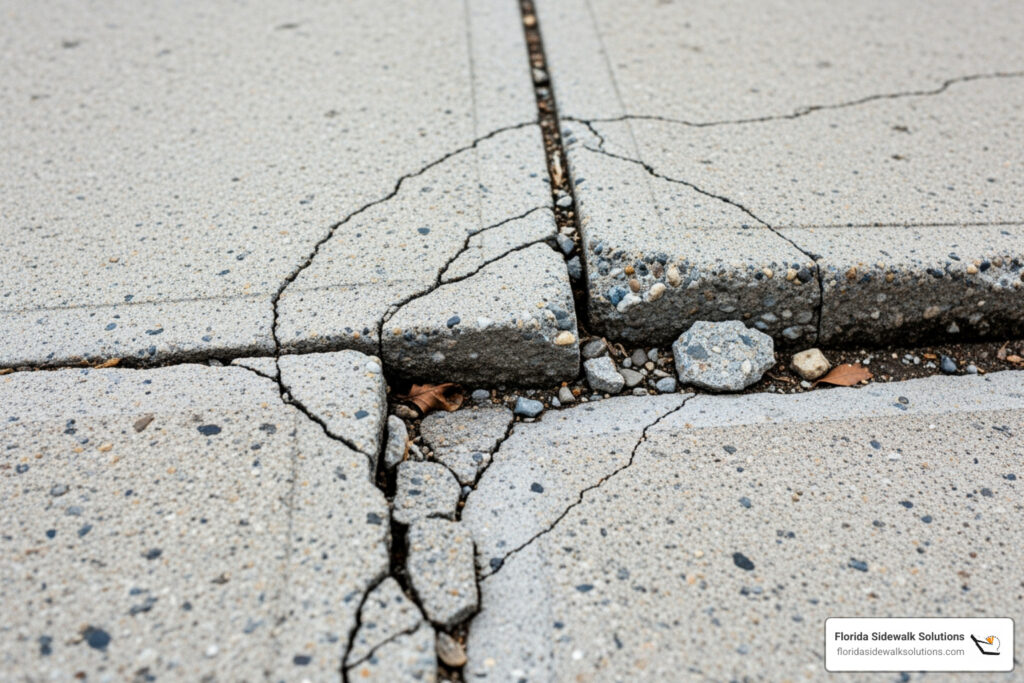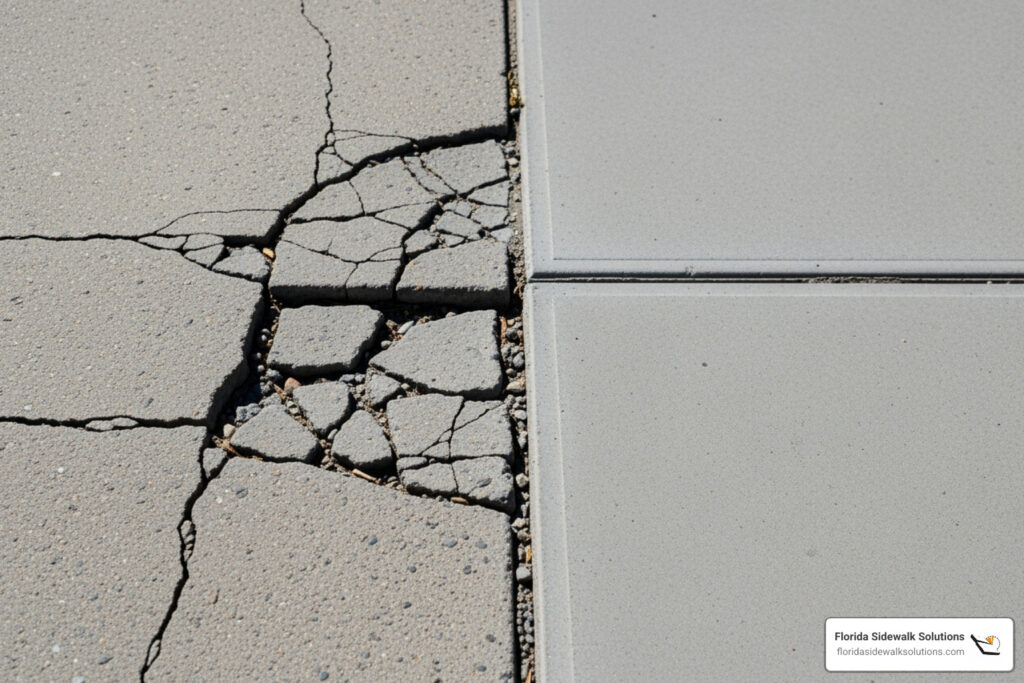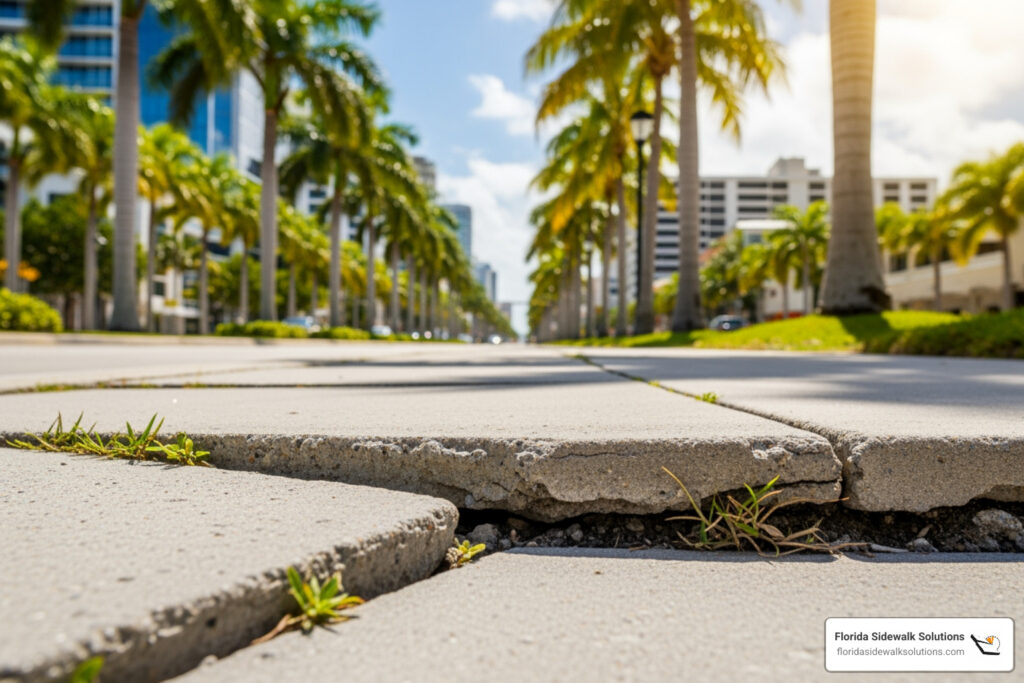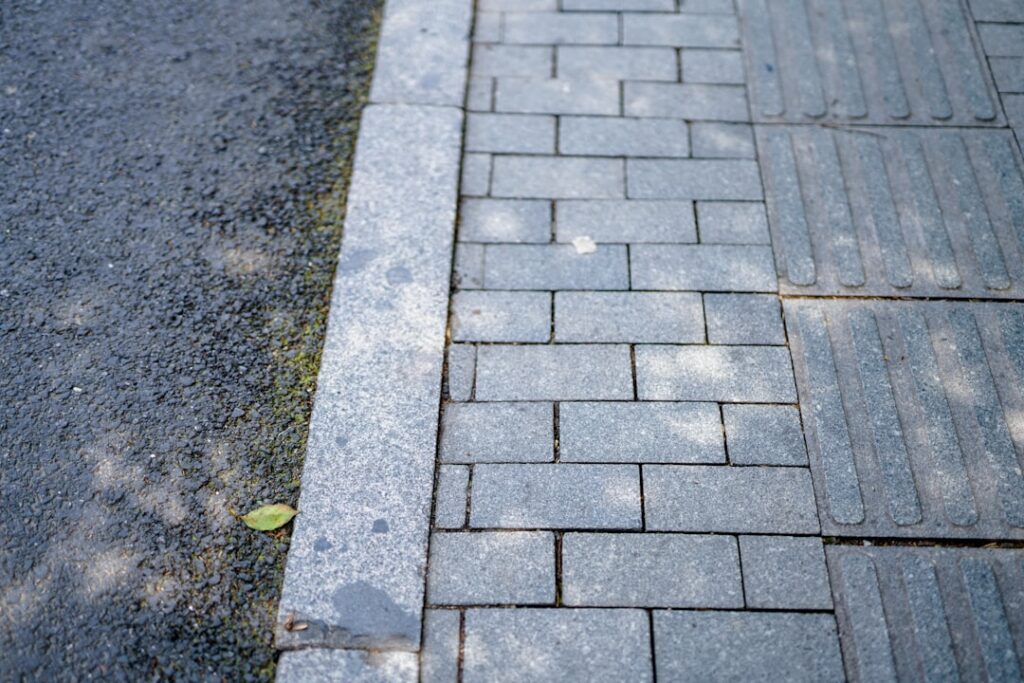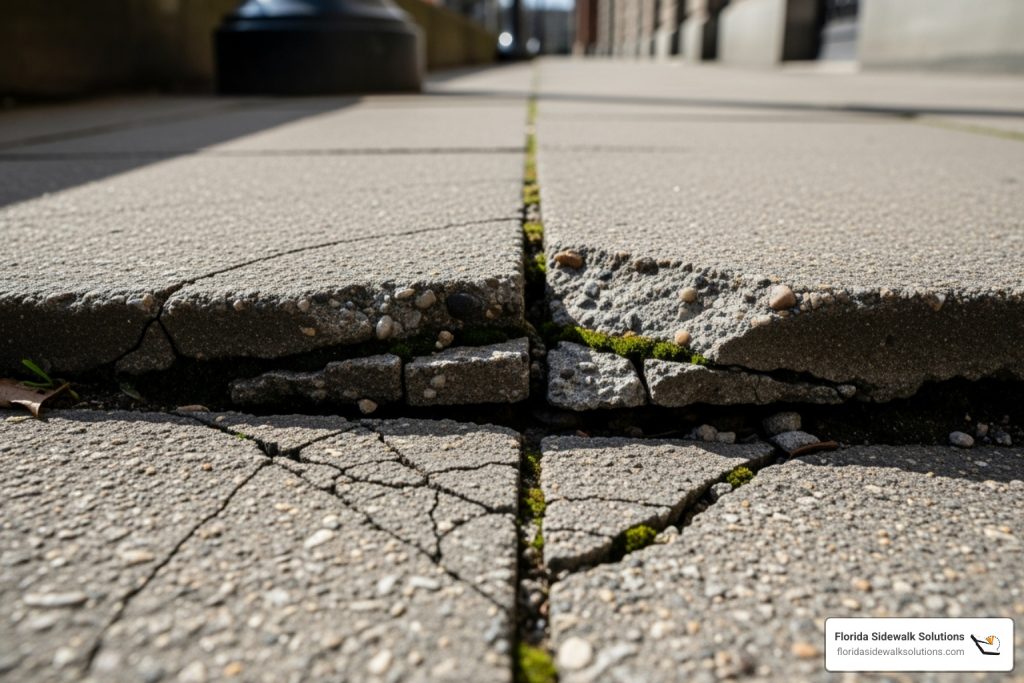Why Cracked Sidewalks Are More Than Just an Eyesore
Cracked sidewalk repair is essential for safety, ADA compliance, and avoiding costly liability. What starts as a simple crack can quickly become a serious problem, especially in Florida’s climate.
Quick Answer: Cracked Sidewalk Repair Methods
- Minor hairline cracks (under 1/4″): DIY caulking or patching compounds.
- Uneven slabs (over 1/4″ height difference): Professional precision cutting or concrete leveling.
- Severe damage (spalling, multiple cracks): Removal and replacement.
- Trip hazards: Immediate professional repair required for ADA compliance.
Cracks are more than an aesthetic issue. The Americans with Disabilities Act (ADA) defines a trip hazard as any vertical change over 1/4 inch. Exceeding this threshold creates a legal liability if someone trips and falls. Water seeps into cracks, eroding the soil beneath and causing slabs to settle unevenly—a process accelerated by Florida’s heavy rainfall. A hairline crack can become a dangerous trip hazard in months.
Property owners are typically responsible for maintaining adjacent sidewalks. Neglect can lead to liability for injuries, reduced curb appeal, and lower property values. For municipal managers, the challenge is finding cost-effective, ADA-compliant solutions that minimize disruption.
Fortunately, modern repair methods like precision concrete cutting offer a faster, more affordable alternative to grinding or replacement. These solutions address trip hazards in minutes, keeping sidewalks safe and communities protected.
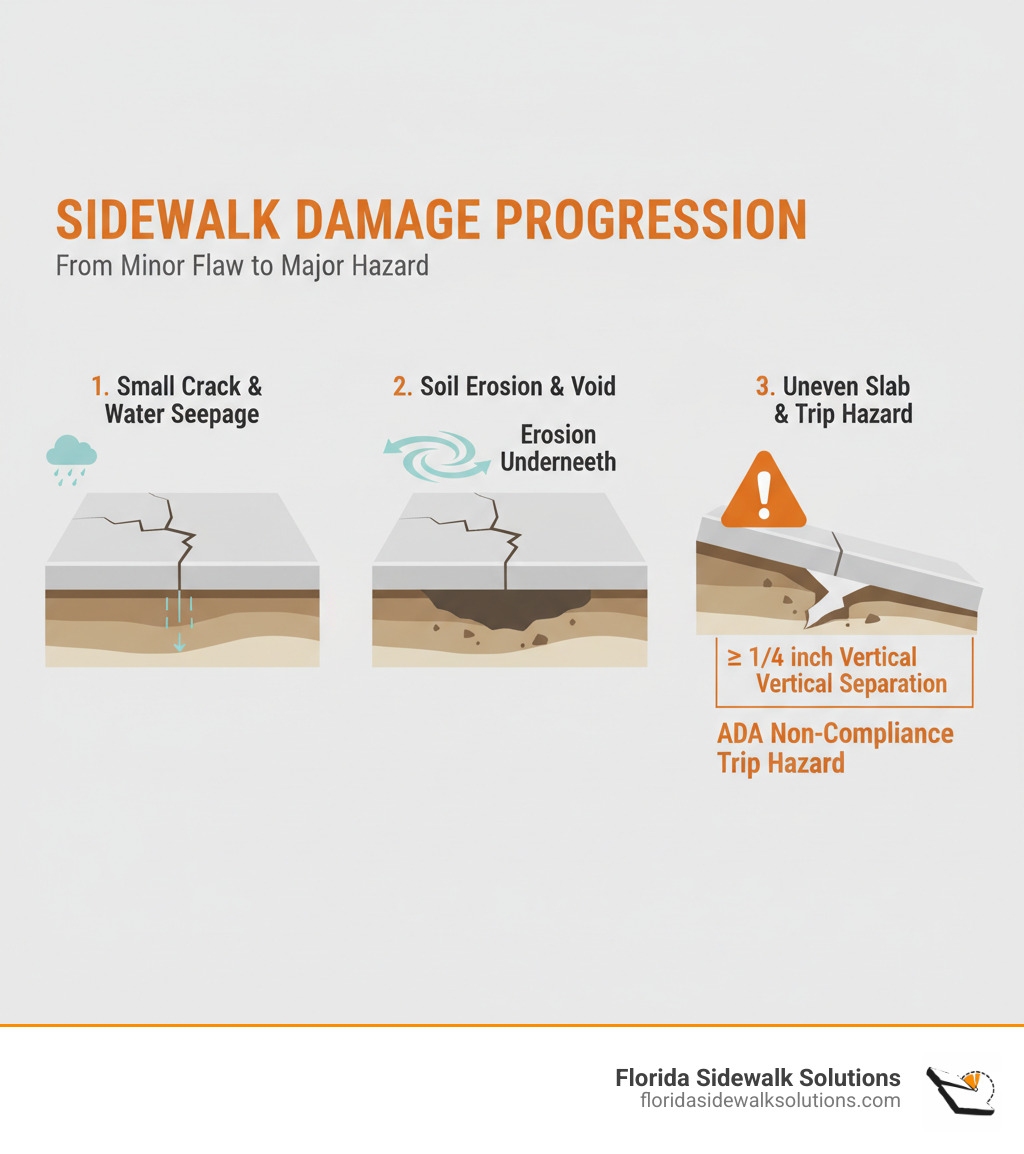
Why Sidewalks Crack and When It Becomes a Hazard
Ever notice how one section of sidewalk suddenly decides to rise up while its neighbor sinks down? It’s not random. Concrete is strong, but it sits on soil that is constantly moving.
The primary culprits are often hidden beneath the surface. Water erosion is a major factor in Florida, as heavy rains wash away soil and create voids under the slab. Poor compaction during installation means the ground settles over time, causing the concrete to sink and crack. Then there are tree roots, which can push slabs upward with surprising force. Finally, heavy loads from vehicles can stress concrete beyond its limits.
When the soil beneath shifts, the brittle concrete has no choice but to crack. Learn more about these common issues on our page about Concrete Cracks and Damage.
Identifying a Trip Hazard
When does a crack become a legal problem? The Americans with Disabilities Act gives a clear answer: any vertical separation over 1/4 inch is a trip hazard. This isn’t a suggestionit’s a legal standard that determines liability. You can review the official ADA guidelines on surface changes for more information.
Other warning signs that your sidewalk needs cracked sidewalk repair include:
- Vertical separation of more than one inch between panels.
- Horizontal cracks wider than an inch, indicating structural issues.
- Spalling, where the surface deteriorates, exposing the aggregate beneath.
- Water pooling after rain, signaling uneven settlement.
- Sections cracked into pieces smaller than one square foot.
If you see these signs, it’s time for professional help. The longer you wait, the worse the problem gets. We cover these issues in detail on our Sidewalk Cracks and Breaks page.
The Role of Florida’s Climate and Soil
Florida’s subtropical climate presents unique challenges for concrete. Our heavy rainfall actively works against your sidewalk, washing away soil from beneath the slabs. This problem is compounded by Florida’s common sandy soil, which erodes more easily than denser soil types.
This soil washout causes voids that lead to settling and cracking. The high water table in many areas means the ground is often saturated, causing it to swell and shrink, constantly stressing the concrete. Unlike northern states where freeze-thaw cycles are the main enemy, our battle is against water infiltration and soil movement. This means proactive maintenance and choosing the right repair method are even more critical here. You can read more about dealing with our unique challenges on our Cracking Sidewalk page.
Repair or Restore? Making the Right Call for Your Sidewalk
When facing a damaged sidewalk, you must decide: can it be repaired, or does it need to be restored? The nature of the damage determines the right course of action, and making the right choice can save you money and future headaches.
Minor damage like hairline cracks may only need patching. But anything creating a trip hazard—that critical 1/4-inch vertical difference—requires immediate, professional attention. At that point, you’re dealing with liability, ADA compliance, and safety.
Fortunately, modern repair methods have evolved beyond the choice between expensive replacement and ineffective patches. Precision cutting technology can address trip hazards without tearing out good concrete, offering a repair at a fraction of the cost of replacement, completed in minutes instead of days. The right solution balances immediate safety needs with long-term durability and cost-effectiveness. Our guide on Fixing Sidewalk Cracks Forming Trip Hazards offers more insights.

DIY Cracked Sidewalk Repair for Minor Issues
For truly minor issues—hairline cracks under 1/4 inch wide or small surface chips—a DIY approach can work. Left alone, water will seep in and worsen the damage. The basic steps are:
- Clean: Use a wire brush and shop vacuum or pressure washer to remove all debris from the crack. It must be completely clean and dry.
- Fill: For narrow cracks, use a flexible masonry crack filler or polyurethane caulk. For wider cracks, use a concrete patching compound. A foam backer rod can be used in deep cracks to save filler.
- Cure: Allow the repair to cure fully according to the product’s instructions. This is critical for durability.
Always wear safety glasses and gloves. While DIY is suitable for cosmetic fixes, it’s not a solution for trip hazards or structural problems.
When to Call a Professional
DIY solutions have clear limits. Attempting to fix significant damage yourself often wastes time and money without addressing the underlying safety issues. It’s time to call a professional for cracked sidewalk repair when you see:
- Uneven or sunken slabs with a vertical difference of more than 1/4 inch.
- Large structural cracks wider than an inch.
- Extensive horizontal gaps or vertical separation between panels.
- Consistent water pooling, indicating severe settlement.
- Widespread spalling or missing sections of concrete.
- Lifting panels caused by tree roots.
- Any ADA non-compliant trip hazard.
Professional repairs provide the long-term durability and safety that DIY fixes can’t match. Our specialists have the equipment to diagnose the root cause and implement a lasting solution. Learn more about why professional repair matters on our The Importance of Professional Cracked Sidewalk Repair page.
Florida Sidewalk Solutions’ Professional Trip Hazard Removal
For sidewalk trip hazards, you need a solution that’s safe, fast, and permanent. At Florida Sidewalk Solutions, we offer a better way to handle cracked sidewalk repair and trip hazard removal, avoiding the mess and expense of traditional methods.
Conventional approaches like concrete grinding create dust and leave rough surfaces, while removal and replacement mean days of disruption and high costs. Our patented precision cutting technology changes everything. We eliminate trip hazards by making precise, smooth cuts that level your concrete sidewalks, delivering a truly ADA-compliant solution.
Our approach focuses on repair longevity and cost-effectiveness. We provide lasting results that stand up to Florida’s climate, with most repairs completed in minutes, not days. Your sidewalk is safe and usable almost immediately. Learn more about our approach to Concrete Sidewalk Crack Repair.

The Florida Sidewalk Solutions Precision Cutting Advantage
Our patented technology is a superior method for trip hazard removal. Instead of grinding or demolishing, we make surgical cuts that create perfectly level transitions between uneven panels. Key advantages include:
- Smooth, ADA-Compliant Finish: We eliminate vertical differences exceeding the 1/4-inch threshold, creating seamless and safe transitions.
- Edge-to-Edge Repair: Our technology reaches the very edges of slabs near walls or landscaping, where grinders can’t.
- No Damage to Adjacent Surfaces: Your landscaping, curbs, and nearby structures remain completely untouched.
- Minimal Disruption: Most repairs are done in minutes. Your sidewalk is immediately safe and ready for use.
- Cost-Effective: By addressing only the hazard without extensive labor or materials, we deliver significant savings. We help create Sidewalk Cracks Fixed and Repaired that are ready for immediate use.
Why Precision Cutting is Superior
Compared to alternatives like grinding, leveling, or replacement, the advantages of our precision cutting method are clear.
- Durability: Patching compounds fail, and grinding leaves surfaces that deteriorate. Our precision cut is a permanent physical alteration of the concrete itself, providing a lasting solution.
- Cost Savings: Full replacement is expensive and labor-intensive. Our efficient process saves you money, often thousands of dollars on larger projects.
- Fast Turnaround: Replacement requires days or weeks for curing. With precision cutting, the sidewalk is usable immediately.
- Clean, Professional Results: Grinders leave dusty, unattractive finishes. Our technology provides a smooth, seamless repair that blends with the existing sidewalk with minimal dust.
- Environmentally Responsible: We use less fuel, contain dust, and conserve resources by repairing instead of replacing, which reduces landfill waste.
We offer a superior solution for Concrete Leveling and Trip Hazard Removal that ensures safety and ADA compliance. When you choose Florida Sidewalk Solutions, you’re choosing a proven method that delivers professional results without the traditional headaches.
Understanding Your Responsibility & Preventing Future Cracks
Many Florida homeowners don’t realize they are likely responsible for the sidewalk in front of their house. If someone trips on a crack you’ve ignored, you could face a lawsuit.
In most Florida municipalities—including Davie, Fort Lauderdale, and Miami—property owners must maintain adjacent sidewalks. This isn’t a suggestion; it’s a local ordinance. Prompt attention to cracks and uneven panels is essential maintenance that protects you from liability. A small crack could cost you thousands if an injury occurs. Our page on Sidewalk Cracks Repair provides more information on addressing these issues.
Who Pays for Repairs: Homeowner vs. The City
The answer is usually straightforward: if the sidewalk is adjacent to your property, you are likely responsible for its maintenance. This includes damage from wear and tear, tree roots from your yard, or general deterioration. Some cities issue a “Notice to Repair,” giving you a deadline. If you fail to comply, the city may perform the repair and bill you for the work plus administrative fees.
The city typically only takes responsibility for sidewalks on public land or when damage is caused by city-owned infrastructure. Don’t assume the city will handle it. If you see a trip hazard, address it promptly. When in doubt, contact your local public works department to clarify their specific regulations.
Proactive Steps for Sidewalk Longevity
Prevention is always better than repair. While you can’t control Florida’s weather, you can take steps to protect your sidewalk:
- Manage Water: Ensure gutters and downspouts direct water away from sidewalks to prevent soil erosion beneath the slabs.
- Landscape Carefully: Be mindful of tree roots. Consider root barriers for trees planted near walkways to prevent future upheaval.
- Seal Your Concrete: Sealing concrete every few years provides a protective barrier against moisture and wear.
- Avoid Heavy Loads: Sidewalks are for foot traffic, not vehicles. Parking on them can cause cracks and compaction issues.
- Inspect Regularly: Walk your sidewalk every few months to catch small cracks or uneven spots early, when fixes are easier and cheaper.
Taking these proactive steps can significantly reduce the need for extensive repairs. Our page on Cracking Sidewalk No Problem offers additional tips.
Frequently Asked Questions about Sidewalk Repair
We talk with homeowners and property managers every day about cracked sidewalk repair. Here are answers to the most common questions.
How much does it cost to repair a cracked sidewalk?
Sidewalk repair costs vary based on the severity of the damage and the chosen repair method. DIY patching is cheap but temporary. Full concrete replacement is the most expensive option due to demolition, materials, and labor.
At Florida Sidewalk Solutions, our precision cutting method is designed to be highly cost-effective. By removing only the hazardous portion of the concrete, we can address trip hazards for significantly less than traditional grinding or replacement. Because our process is fast, you save on labor costs. We provide free, custom estimates so you know the exact cost to make your walkway safe. Visit our Sidewalk Crack Repair Service page to get started.
How long do sidewalk repairs last?
The longevity of a repair depends entirely on the method. DIY patches and caulking are temporary, often failing within a year or two in Florida’s climate. Traditional grinding can leave a rough surface that deteriorates over time.
Our precision cutting method offers exceptional longevity. We are not adding a patch that can fail; we are making a permanent physical alteration to the concrete slab itself. By precisely leveling the concrete, we create a repair that is as durable as the original sidewalk. As long as the underlying soil has stabilized, you get a reliable, ADA-compliant solution that lasts for years. See more about our durable approach on our Cracked Sidewalk Repairs FSS page.
Is a cracked sidewalk covered by homeowner’s insurance?
This is a tricky question, but the answer is usually no. Most homeowner’s insurance policies do not cover gradual wear and tear or damage from neglect, which is how they view most sidewalk cracks. They consider this a standard maintenance issue for the property owner.
However, the liability portion of your policy is a different story. If someone is injured from a fall on your cracked sidewalk, your liability coverage may help with legal fees and settlement costs. This is why proactive repair is so critical—it protects you from costly claims. In rare cases, if the sidewalk is damaged by a sudden, covered event (like a tree falling in a storm), the repair might be covered. Always review your policy, but the best approach is proactive cracked sidewalk repair to prevent accidents from happening in the first place.
Conclusion
Your sidewalk tells a story. A cracked, uneven surface speaks of neglect and danger, but it doesn’t have to. Prompt cracked sidewalk repair is about more than avoiding lawsuits; it’s about ensuring safety, maintaining property value, and showing you care about your community.
We’ve seen that while DIY fixes have their place for minor cosmetic issues, professional repair is essential for addressing true trip hazards, especially those defined by the ADA’s 1/4-inch rule. Modern technology has made these professional repairs more accessible than ever.

At Florida Sidewalk Solutions, we’ve revolutionized trip hazard removal. Our patented precision cutting technology creates smooth, ADA-compliant surfaces in minutes, not days. It’s a fast, clean, and permanent solution that costs significantly less than traditional replacement.
Don’t let a cracked sidewalk become tomorrow’s lawsuit. Whether you’re a homeowner, property manager, or municipal official, we are here to help. Our team provides free estimates and can often complete repairs the same day.
Your community deserves safe sidewalks. You deserve the peace of mind that comes from a job done right.
Ready to transform your dangerous trip hazards into smooth, safe pathways? Find expert sidewalk repair near me and get your free estimate today. Let’s make your sidewalks safe again.



